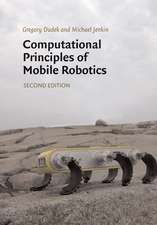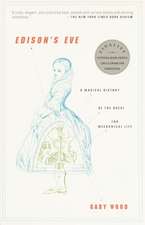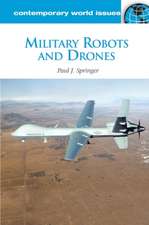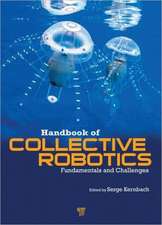Quality Control in Automation
Autor Ken. Stouten Limba Engleză Paperback – 26 noi 2012
Preț: 386.22 lei
Nou
Puncte Express: 579
Preț estimativ în valută:
73.91€ • 80.26$ • 62.09£
73.91€ • 80.26$ • 62.09£
Carte tipărită la comandă
Livrare economică 22 aprilie-06 mai
Preluare comenzi: 021 569.72.76
Specificații
ISBN-13: 9781468475012
ISBN-10: 1468475010
Pagini: 264
Ilustrații: 260 p.
Dimensiuni: 155 x 235 x 14 mm
Greutate: 0.37 kg
Ediția:Softcover reprint of the original 1st ed. 1985
Editura: Springer Us
Colecția Springer
Locul publicării:New York, NY, United States
ISBN-10: 1468475010
Pagini: 264
Ilustrații: 260 p.
Dimensiuni: 155 x 235 x 14 mm
Greutate: 0.37 kg
Ediția:Softcover reprint of the original 1st ed. 1985
Editura: Springer Us
Colecția Springer
Locul publicării:New York, NY, United States
Public țintă
ResearchCuprins
1: The Need for Quality Control.- Control considerations.- 2: Process Variability.- Dimensional error.- Common errors.- Establishing and controlling process capability.- Collecting data.- 3: Probability Theory.- Empirical probability.- Theoretical probability.- Addition law of probability 2.- Multiplication law of probability.- Multiple sampling of large batches.- Binomial expansion.- Sampling small batches.- Law of permutations.- 4: Location and Scatter.- Measures of location.- Calculation of mean, median and mode.- Relationship between mean, median and mode.- Measures of scatter.- Calculations of measures of scatter.- 5: Useful Distributions.- Hypergeometric distribution.- Binomial distribution.- Poisson distribution.- Distribution of continuous data.- Normal (Gaussian) distribution.- 6: Measurement and Control of Workpiece Size.- In-process measurement.- Post-process measurement.- Advantages of process control.- Control and pre-control charts.- Modified control charts.- Control charts for proportion defective: P charts.- d Charts, sampling the number of defects within one sample.- Interchangeability of P and d charts.- 7: Sampling Inspection.- Single sampling inspection plan.- Producer and consumer risks.- Double sampling schemes.- Sequential sampling.- AOQL: a basis for acceptability sampling.- 8: Statistical Tolerances.- Variability of a single dimension.- Variability of stacked dimensions.- Unequal tolerance applications.- Assembly condition of clearance.- Acceptable levels of defective assemblies.- Implementation of statistical tolerances.- The implications of statistical tolerancing.- 9: Confidence Limits and Tests of Significance.- Unbiased estimates of population parameters based on sample observations.- Standard deviation of the distribution of the sum or difference of two variates.- Estimate of population standard deviation based on two samples.- Distribution of sample means.- Student’s ‘t’distribution.- Single-tailed or double-tailed tests.- Variance ratio (F) test (Fisher’s ratio).- Selection of levels of significance.- Confidence limits for populations whose standard deviation is known.- The t-test for a single mean.- The t-test for the means of paired observations.- The t-test for the difference of the means of two independent samples.- Test of variance and difference of mean of two independent samples.- ‘Chi-square’ test.- Contingency tables.- 10: Analysis of Variation.- Variance between sample averages.- Calculation of control charts from the residual variance estimate.- 11: Cumulative Sum Charts.- Decision making with ‘V’ masks.- Design of cusum schemes.- Design of ‘V’ masks.- 12: Reliability.- Product life and failure characteristics.- Life characteristic curve.- Exponential distribution model.- Effect of working environment.- Additivity of failure rate.- Failure in parallel systems.- Reliability life tests.- Weibull probability distribution.- 13: Pareto Analysis.- Developing a pareto diagram.- Reassessment after process or design change.- 14: Variability when Sampling Gaussian and non-Gaussian Populations.- Random sampling from Gaussian populations — uncorrelated.- Random sampling from Gaussian populations — correlated.- Variation in non-normal surfaces.- 15: Effect of Quality on the Economics of Assembly Processes.- Assembly machines.- The cost of quality.- Optimization of parts quality.- Manually assembled products.- 16: Selection and Effectiveness of Quality Engineers and Inspectors.- Selection of quality assurance managers.- Selection of quality engineers.- Selection of semi-skilledinspectors.- Selection of skilled inspectors.- Effectiveness of inspectors.- Inspector assessment.- Implications of inspector inefficiency.- 17: Automated Inspection.- A simple measuring system.- Types of control system: in-process measurement.- Errors introduced by measuring systems.- Gauging systems.- Application of in-process measurement.- Post-process gauging.- System specification.- Examples of hardware associated with an automated low cost gauging system.- 18: Visual Inspection.- Principle of the television camera.- Charge coupled devices.- Components of a vision system.- Monochromatic lighting.- Achievement of binary images from video pictures.- Evaluation of the component.- Orientation.- Simple optical systems.- System specification.












